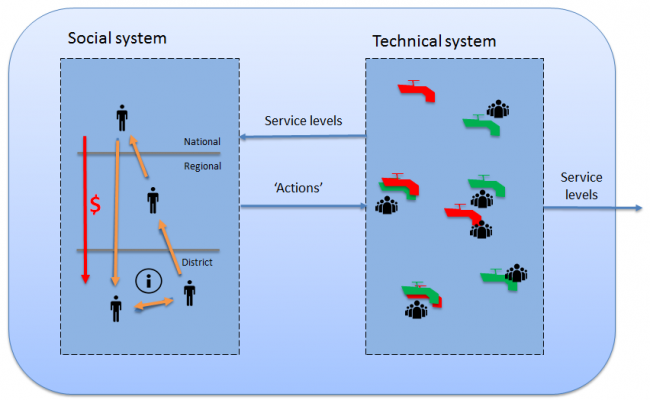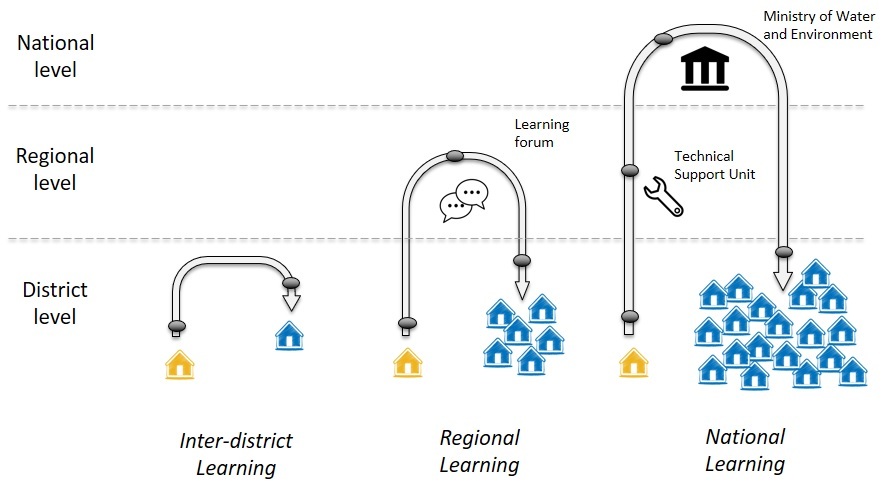The role of learning in water supply systems in rural Uganda.
Published on: 19/09/2016
This news item is based on an interview with independent researcher Felix Knipschild.
"My professor always says 'The best model is a model you can throw away immediately.' Because you create a model to gain certain insights, if the model is successful you gain those insights and do not need the model anymore."
– Felix Knipschild (independent researcher)
Only 65% of Uganda's population has access to safe and clean water. In rural Uganda progress in water service delivery is frustrated by insufficient resources, inefficient resource allocation and a focus on projects rather than the delivery of sustainable services. Promisingly, there are quite a number of success stories where local organisations manage to deliver sustainable water services. This raises the question how these local organisations and governments can learn from these success stories.
For six months Felix Knipschild worked as an independent researcher in cooperation with IRC to explore the influence of different learning structures on the performance of district water service levels in Uganda. This is examined by defining 'learning' from a complex systems perspective; making a simplification of the water system in Uganda; and finally capturing the rural water supply system in Uganda in a computer simulation to measure the performance of various structures in which local organisations can learn from each other. The aim of this research was to analyze how information is disseminated through the system and when it is used by other districts as a proxy for 'learning'. The IRC Uganda team facilitated access to required data.
In the water system in rural Uganda we can distinguish between technical and social systems. As the picture below visualizes, in a social system we can observe a multi-level governance situation where interactions between organisations at different institutional levels lead to decisions about the water infrastructure - for instance installing a new water infrastructure or repairing a broken infrastructure. In a technical system a water infrastructure provides services to people.

Within this research the theory of 'cultural evolution' has been used to define 'learning'. In short, this entails the evolvement of an idea or information along the way. People pass along the idea or information, therefore it changes through perspectives, (mis)understandings, thoughts and so forth. Over a period of time the initial idea or information has evolved. The picture below shows three structures that local organisations in rural Uganda can use to learn from each other.

Inter-district learning takes place directly between two districts. Regional learning involves multiple districts with a platform at regional level. In the national learning structure a local success in one district is disseminated to other districts via an initiative by the Ministry or by national law. Learning is defined as the moment when a success story (e.g., a successful policy) is transferred from one district to another.
The effect of each learning structure on the performance of the rural water supply system as a whole is simulated in a computer based model. In this model an abstraction of all rural districts in Uganda is present and they interact with each other over a simulated period of 20 years. Every year each district receives budget from the Ministry and invests in water pumps and informs other districts what they did so they can learn from success stories. The computer simulation tests for inter-district, regional and national learning. One learning structure at the time is tested. Then the performance of the districts is compared for each learning structure. The water service levels are measured by water quality, water quantity, reliability and accessibility.
The model showed that the greater the scale of communication was (district – regional – national), the higher the average performance of the districts was. It also showed that the greater the scale of communication, the more extremely good and extremely bad situations were encountered. This means a success story in one district is not necessarily a success in other districts.
This research offered several insights. Firstly, organisations in rural Uganda use learning structures in parallel. Secondly, a computer model can generate insights into the isolated effect of learning structures in relation to performance. This can be useful for policy makers to prioritise resources. For example, to stimulate inter-district learning when aiming for stability or to train organisations in the national structure to identify success stories that can be generalised to all other districts.
Furthermore, an interesting policy insight came to light. In Uganda 70% of the budget needs to be spent on the construction of new water infrastructure. This is a sufficient amount of money to build facilities but not to maintain and sustain these services. The study showed if the policy would be changed the districts would gradually learn from each other to invest a larger share of the budget in maintaining the existing infrastructure.
First of all, this study has given insight in the process of learning. It sheds light on which actors in a water supply system are learning and how the learning takes place. The definition of learning can be useful for the next research steps in WASH sector learning and the practical implementation of measures to improve local learning initiatives. Secondly, the research has unravelled a lot of detailed information, because it was necessary to define and investigate the situation and processes in detail to be able to convert the information into data for the model. For example, it has brought to light the above mentioned influence of the 70% budget policy. This detailed information can be helpful in improving the water supply systems in Uganda. Thirdly, Felix thinks that this computer simulation model could form the foundation for the development of a simulation tool for IRC.